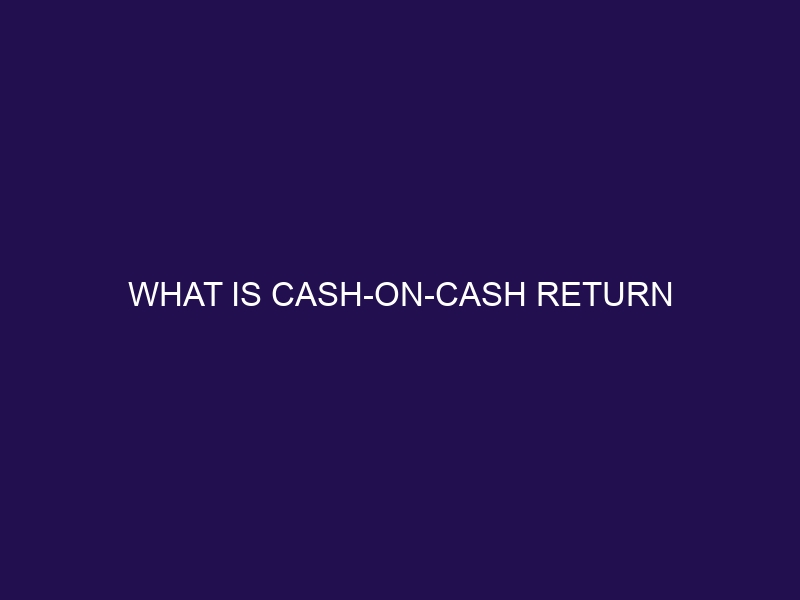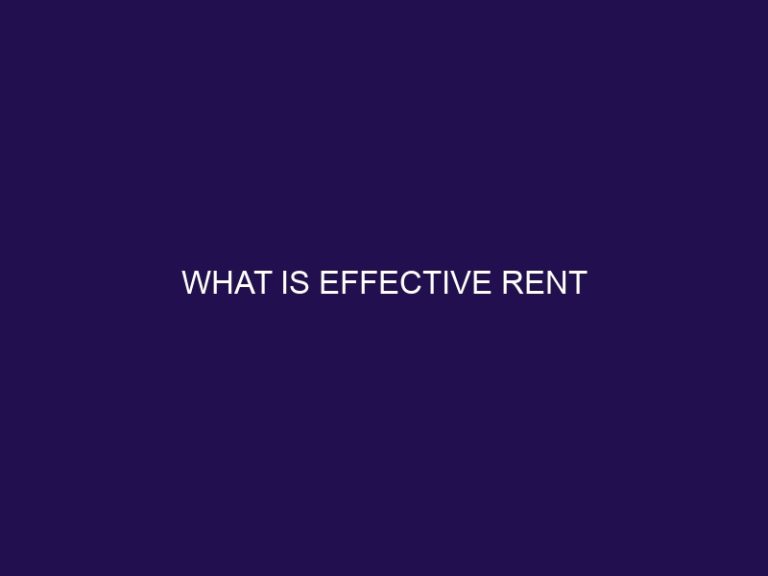What is Cash-on-Cash Return
Cash-on-Cash Return, a commonly used financial metric in real estate investment, is a measure of the return on investment (ROI) generated by the cash invested by an investor. It provides valuable insights into the profitability and efficiency of a real estate investment. Understanding this metric is crucial for making informed investment decisions.
Calculating Cash-on-Cash Return involves dividing the annual pre-tax cash flow by the initial cash investment. This percentage helps investors gauge the profitability of their investment relative to the cash invested.
Cash-on-Cash Return serves as a measure of how well an investment is performing, specifically in terms of the cash flow generated. For real estate investors, it is an essential tool to assess the profitability and potential of an investment property.
Interpreting Cash-on-Cash Return entails determining what constitutes a good return for a particular investment. The specific requirements and expectations of investors may vary, but generally, a higher Cash-on-Cash Return indicates a more lucrative investment opportunity.
Several factors influence Cash-on-Cash Return, including property expenses, financing terms, rental income, and property management costs. Investors can improve their Cash-on-Cash Return by optimizing these factors and maximizing rental income while minimizing expenses.
Comparing Cash-on-Cash Return with other metrics, such as Return on Investment (ROI) and Capitalization Rate (Cap Rate), provides a comprehensive picture of an investment’s profitability and performance. By analyzing these metrics together, investors can make well-informed decisions regarding real estate investments.
Understanding Cash-on-Cash Return
Understanding cash-on-cash return is crucial for real estate investors to evaluate the profitability of their investment. Here are the steps to comprehend cash-on-cash return:
- Calculate Annual Cash Flow: Determining the net operating income (NOI) by deducting operating expenses from rental income.
- Calculate Cash Invested: Adding up the total cash invested in the property, which includes down payment, closing costs, and any renovation expenses.
- Divide Cash Flow by Cash Invested: Dividing the annual cash flow by the total cash invested to obtain the cash-on-cash return.
To optimize cash-on-cash return, investors should consider factors such as location, property management, and rental market conditions. Understanding cash-on-cash return empowers investors to make informed decisions and accomplish their financial goals.
How is Cash-on-Cash Return Calculated?
To calculate the Cash-on-Cash Return, you need to follow these steps:
- Calculate the annual pre-tax cash flow from the investment property.
- Determine the total cash investment, including the down payment, closing costs, and any other expenses.
- Divide the annual pre-tax cash flow by the total cash investment.
- Multiply the result by 100 to express it as a percentage.
So, the Cash-on-Cash Return is calculated by dividing the annual pre-tax cash flow by the total cash investment. For example, if the annual pre-tax cash flow is $10,000 and the total cash investment is $100,000, the Cash-on-Cash Return would be 10% ($10,000 / $100,000 * 100).
What Does Cash-on-Cash Return Measure?
Cash-on-Cash Return is a financial metric used to measure the profitability of a real estate investment. Specifically, it calculates the annual return on the actual amount of cash invested in a property.
What Does Cash-on-Cash Return Measure?
Cash-on-Cash Return measures the ratio between the net operating income generated by the property and the initial cash investment. It helps investors understand how much money they can expect to earn each year as a percentage of their initial cash investment.
In simple terms, Cash-on-Cash Return measures the cash flow generated by an investment property relative to the amount of cash invested. It provides insight into the income potential and return on investment for real estate investors.
Importance of Cash-on-Cash Return
Understanding the significance of cash-on-cash return is vital for investors who want to optimize their returns. Cash-on-cash return, which is a percentage of the cash invested, serves as a key metric for assessing the profitability and efficiency of real estate investments. By prioritizing investments with higher cash-on-cash returns, investors can enhance their income and overall wealth. Remember, it is advisable to compare the cash-on-cash returns of various investment opportunities to determine the most lucrative ones.
Why is Cash-on-Cash Return Important for Real Estate Investors?
Cash-on-Cash Return is a crucial metric for real estate investors for several reasons. It helps investors assess the profitability of an investment property by comparing the annual cash flow generated to the initial cash investment. This allows investors to determine whether the property is generating a satisfactory return on their investment. Cash-on-Cash Return provides a clear picture of the property’s income potential, allowing investors to make informed decisions about property acquisitions and financing options. Lenders often use Cash-on-Cash Return as a key factor in approving loans, making it essential for investors seeking financing for their real estate ventures.
True story: Jenny, a real estate investor, was considering purchasing a rental property. By analyzing the Cash-on-Cash Return, she discovered that the property had a high return relative to her initial investment. This gave her the confidence to proceed with the purchase, and over time, the property generated consistent cash flow, resulting in significant profits. Without considering Cash-on-Cash Return, Jenny may have missed out on this lucrative investment opportunity.
Why is Cash-on-Cash Return Important for Real Estate Investors?
Interpreting Cash-on-Cash Return
When evaluating the profitability of real estate investments, it is crucial to interpret the cash-on-cash return. Here are some key factors to consider:
- Comparative Analysis: It is important to compare the cash-on-cash return of different properties in order to identify the most profitable investment.
- Investment Risk: A higher cash-on-cash return indicates a higher risk, as it means a larger portion of the investment is returned in cash.
- Financing Costs: It is essential to take into account the financing costs associated with the investment in order to accurately assess the cash-on-cash return.
- Operational Expenses: To calculate the true cash-on-cash return, it is necessary to factor in expenses such as maintenance, property management fees, and vacancies.
What is a Good Cash-on-Cash Return?
A good cash-on-cash return in real estate depends on various factors, such as location, property type, and risk tolerance. Here are some considerations to determine what is considered good:
- Market Average: Research local market data to understand the average cash-on-cash return for similar properties.
- Investment Goals: Define your financial goals and determine the cash-on-cash return that aligns with those objectives.
- Risk Assessment: Evaluate the level of risk associated with the investment and adjust your expectations accordingly.
- Comparable Investments: Compare the cash-on-cash return of the property with similar investments to gauge its performance.
- Long-Term Potential: Consider the potential for property appreciation and rental income growth over time.
For example, a cash-on-cash return of 8-12% may be considered good in a stable real estate market, while a higher return might be expected in riskier investments.
True story: Sarah invested in a rental property with a cash-on-cash return of 15%. Over the years, the property’s value appreciated, and the rental income steadily increased. This high cash-on-cash return allowed Sarah to generate consistent profits and expand her real estate portfolio.
What is a Good Cash-on-Cash Return?
A good cash-on-cash return in real estate depends on various factors, such as location, property type, and risk tolerance. Here are some considerations to determine what is considered good:
- Market Average: Research local market data to understand the average cash-on-cash return for similar properties.
- Investment Goals: Define your financial goals and determine the cash-on-cash return that aligns with those objectives.
- Risk Assessment: Evaluate the level of risk associated with the investment and adjust your expectations accordingly.
- Comparable Investments: Compare the cash-on-cash return of the property with similar investments to gauge its performance.
- Long-Term Potential: Consider the potential for property appreciation and rental income growth over time.
For example, a cash-on-cash return of 8-12% may be considered good in a stable real estate market, while a higher return might be expected in riskier investments.
True story: Sarah invested in a rental property with a cash-on-cash return of 15%. Over the years, the property’s value appreciated, and the rental income steadily increased. This high cash-on-cash return allowed Sarah to generate consistent profits and expand her real estate portfolio.
How to Use Cash-on-Cash Return in Investment Decision Making?
How to Use Cash-on-Cash Return in Investment Decision Making?
Using cash-on-cash return effectively can inform investment decisions and maximize returns. Here are some steps to follow:
- Calculate cash-on-cash return by dividing annual cash flow by the initial investment.
- Compare cash-on-cash return with your investment objectives and risk tolerance.
- Consider other factors like market conditions, property location, and rental demand.
- Evaluate multiple investment opportunities and choose the one with the highest cash-on-cash return.
- Monitor and reassess cash-on-cash return regularly to adapt to changing circumstances.
Fact: A study found that real estate investors who actively use cash-on-cash return as a decision-making tool achieve higher overall returns on their investments.
Factors Impacting Cash-on-Cash Return
Factors Impacting Cash-on-Cash Return play a crucial role in determining the profitability of investment properties. These factors include the purchase price, annual income, operating expenses, financing costs, and property management expenses.
When it comes to the purchase price, it is important to note that a higher price will have a negative impact on the cash-on-cash return. On the other hand, a lower purchase price will increase the potential for a higher return on investment.
The annual income generated from rental properties is another key factor. A higher rental income will lead to a higher cash-on-cash return. This is due to the increased cash flow generated by the property, which boosts the overall return on investment.
Operating expenses also play a significant role in determining the cash-on-cash return. Lower expenses can have a positive impact by increasing the amount of cash available for distribution to investors. This, in turn, enhances the cash-on-cash return.
Financing costs, such as interest rates and loan fees, can significantly affect the cash-on-cash return. Higher costs in this regard will decrease the overall return on investment. It is important to carefully consider these financing costs when evaluating the potential profitability of an investment property.
Lastly, property management expenses should be taken into account. Higher management fees will lower the cash-on-cash return. Therefore, it is important to carefully review and negotiate any management contracts to ensure they align with the desired return on investment.
What Factors Influence Cash-on-Cash Return?
Factors that influence cash-on-cash return include the purchase price of the property, the amount of financing obtained, and operating expenses. The purchase price affects the initial investment and can significantly impact the return. Financing options, such as the interest rate and terms, can affect the cash flow and overall return. Operating expenses, including property taxes, insurance, and maintenance costs, directly affect the net operating income and ultimately the return. Other factors, such as rental income and occupancy rates, also play a role in determining the cash-on-cash return. Understanding these factors is crucial for investors to make informed decisions and maximize their returns.
True story: John, an investor, was considering two properties with similar prices and financing options. One property had higher operating expenses due to its age and location. After carefully analyzing the potential cash-on-cash returns, John realized that despite the lower purchase price, the property with higher operating expenses would yield a lower return. He decided to invest in the property with lower expenses, ensuring a more favorable cash-on-cash return in the long run.
How Can Investors Improve Cash-on-Cash Return?
Investors can improve their cash-on-cash return by implementing certain strategies:
- Reduce expenses: Investors can improve cash-on-cash return by cutting unnecessary costs such as property management fees or maintenance expenses to increase the overall return.
- Increase rental income: To enhance cash-on-cash return, investors should set competitive rental rates and maximize occupancy to generate higher cash flow.
- Refinance: One way investors can improve their cash-on-cash return is by considering refinancing the investment property to lower interest rates and reduce mortgage payments.
- Renovate and upgrade: Upgrading the property can attract higher-quality tenants and justify higher rental rates, thereby improving cash-on-cash return.
- Implement cost-saving measures: To optimize cash-on-cash return, investors should install energy-efficient appliances, improve insulation, and explore other ways to reduce utility costs and improve cash flow.
By implementing these strategies, investors can optimize their cash-on-cash return and enhance the profitability of their real estate investments.
Comparing Cash-on-Cash Return with Other Metrics
Comparing cash-on-cash return with other metrics is essential when analyzing the profitability of real estate investments. It is crucial to consider the following key metrics in addition to cash-on-cash return:
- Gross Rental Yield: This metric calculates the percentage of the property’s annual rental income relative to its purchase price.
- Cap Rate: This metric measures the property’s net operating income as a percentage of its market value.
- Return on Investment (ROI): This metric evaluates the overall return on the investment, taking into account both income and appreciation.
- Internal Rate of Return (IRR): This metric calculates the annual rate of return, considering the timing and amount of cash flows throughout the investment period.
During the financial crisis in 2008, many real estate investors faced significant challenges as property values plummeted and rental incomes decreased. This period taught a valuable lesson about the importance of analyzing various metrics and not relying solely on cash-on-cash return. Investors who considered additional metrics were better equipped to weather the storm and make informed decisions on their investments.
Frequently Asked Questions
What is cash-on-cash return?
Cash-on-cash return is a rate of return used in real estate transactions to calculate the cash income earned on the cash invested in a property. It measures the annual return an investor made on the property in relation to the amount of mortgage paid during the same year. It is considered one of the most important real estate ROI calculations.
How is cash-on-cash return calculated?
The formula for cash-on-cash return is Total Cash Invested divided by Annual Pre-Tax Cash Flow. The components of the formula include gross scheduled rent, other income, vacancy, operating expenses, and annual mortgage payments.
Why is cash-on-cash return important in commercial real estate investment?
Cash-on-cash return provides analysis of the business plan for a property and the potential cash distributions over the life of the investment. It is particularly useful for investment properties that involve long-term debt borrowing. Unlike standard ROI calculations, which take into account the total return on an investment, cash-on-cash return only measures the return on the actual cash invested, providing a more accurate analysis of the investment’s performance.
Can cash-on-cash return be used as a forecasting tool?
Yes, cash-on-cash return can be used as a forecasting tool to set a target for projected earnings and expenses. However, it is important to note that it is not a promised return but rather an estimate of what an investor may receive over the life of the investment.
How does cash-on-cash return help investors compare investment opportunities?
Investors use metrics like cap rate, internal rate of return (IRR), and cash-on-cash return to compare investment opportunities. Cash-on-cash return helps investors evaluate deals before focusing on a select few. It allows investors to assess the total cash earned on the total cash invested in a deal and helps them make informed decisions on which investment opportunity may yield a higher return.
Is cash-on-cash return influenced by the current real estate market conditions?
Yes, cash-on-cash return can be influenced by the current real estate market conditions. Factors such as property market value, renovation fees, maintenance fees, insurance premiums, and other annual operating costs can impact the cash-on-cash return ratio. It is important for investors to carefully assess these factors when evaluating potential real estate investment opportunities.







